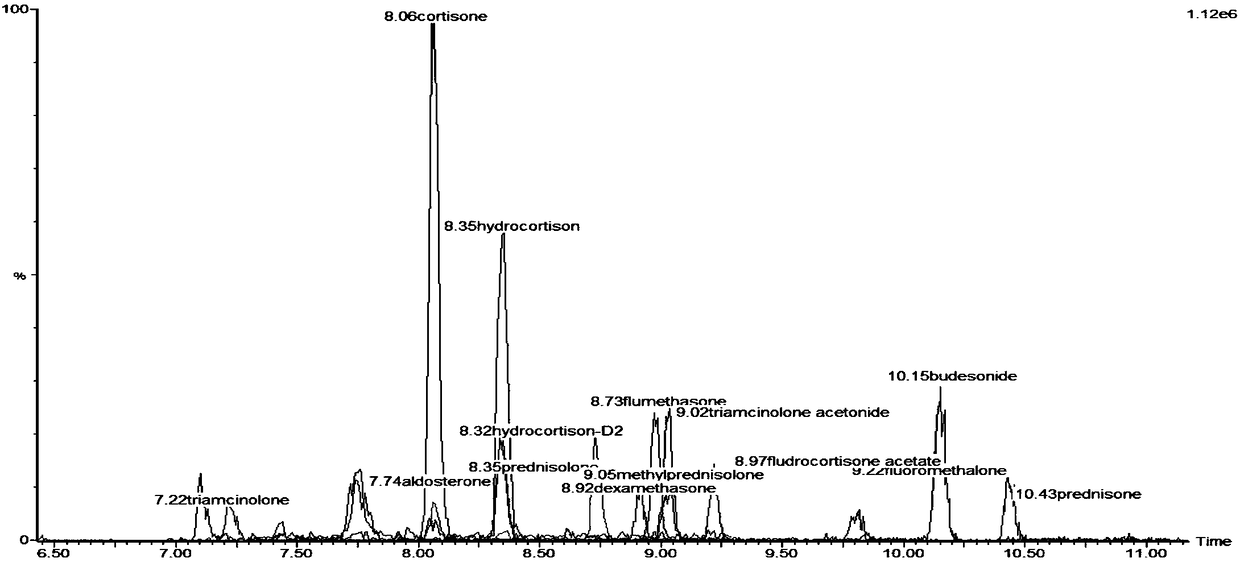Liquid chromatography-tandem mass spectrometry method used for simultaneous detection of 10 kinds 94 residual drugs in livestock and poultry
A technology of residual drugs and liquid chromatography, which is applied in the direction of measuring devices, instruments, scientific instruments, etc., can solve the problems of simultaneous purification of multiple types of veterinary drugs, and achieve the effect of rapid detection methods, improved efficiency, and economical use
- Summary
- Abstract
- Description
- Claims
- Application Information
AI Technical Summary
Problems solved by technology
Method used
Image
Examples
preparation example Construction
[0100] A. Preparation of internal standard stock solution:
[0101] Dilute 1mg of sulfamethazine-d5, sulfamethazine-D5, demetonidazole-D3, hydrocortisone-D3, thiamphenicol-D3, florfenicol-D3, clindamycin respectively with methanol Sodium-D3 and erythromycin-13CD2 were respectively dissolved in 10mL volumetric flasks to prepare an internal standard stock solution with a concentration of 100μg / mL, stored at -18°C in the dark, and valid for 1 year. Nalidixic acid-D5, norfloxacin-D5, pefloxacin-D5, enrofloxacin-D5, flufloxacin-D3, and chloramphenicol-D5 are commercial reference solutions with a concentration of 100 μg / mL .
[0102] B. Preparation of isotope internal standard working mixture: Precisely measure 0.050mL of each of the above-mentioned standard stock solutions in a 20.0mL volumetric flask, dilute with methanol to constant volume, and prepare mixed standard working solutions with concentrations of 250μg / L, respectively, - Store in the dark at 18°C, valid for 2 months....
Embodiment 1
[0119] A liquid chromatography-tandem mass spectrometry method for the simultaneous determination of 94 drug residues in 10 categories in livestock and poultry, including:
[0120] Sample preparation steps: Take the chicken sample, remove the skin and bones, and use a meat grinder to make meat paste for the meat tissue part, obtain the sample to be tested, mix it and put it in a sealed packaging bag, and store it in a freezer below -18°C for later use;
[0121] Extractant preparation steps: take acetonitrile, water and formic acid, mix them evenly, and obtain the extractant; wherein, the volume ratio of water, acetonitrile and formic acid is 20:80:0.1;
[0122] Sample extraction steps: Accurately weigh 2.0 g of the sample to be tested, place it in a 50 mL centrifuge tube, accurately add 0.2 mL of the isotope internal standard working mixture, then add 9.8 mL of the extractant, homogenize at a speed of 12000 r / min for 2 min, Obtain the first analysis solution; centrifuge the fi...
Embodiment 2
[0135] The difference between embodiment 2 and embodiment 1 is: in the extractant, the volume ratio of water and acetonitrile is 10:90. Others are identical with specific embodiment 1.
PUM
| Property | Measurement | Unit |
|---|---|---|
| recovery rate | aaaaa | aaaaa |
| recovery rate | aaaaa | aaaaa |
| correlation coefficient | aaaaa | aaaaa |
Abstract
Description
Claims
Application Information
 Login to View More
Login to View More - R&D Engineer
- R&D Manager
- IP Professional
- Industry Leading Data Capabilities
- Powerful AI technology
- Patent DNA Extraction
Browse by: Latest US Patents, China's latest patents, Technical Efficacy Thesaurus, Application Domain, Technology Topic, Popular Technical Reports.
© 2024 PatSnap. All rights reserved.Legal|Privacy policy|Modern Slavery Act Transparency Statement|Sitemap|About US| Contact US: help@patsnap.com










